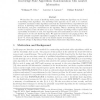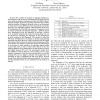570 search results - page 12 / 114 » On the number of zero-sum subsequences |
ALGORITHMICA
2011
13 years 4 months ago
2011
We introduce the concept of knowledge states; many well-known algorithms can be viewed as knowledge state algorithms. The knowledge state approach can be used to to construct comp...
BIBE
2007
IEEE
14 years 4 months ago
2007
IEEE
Abstract—We consider the problem of aligning multiple protein sequences with the goal of maximizing the SP (Sum-of-Pairs) score, when the number of sequences is large. The QOMA (...
VLSI
2012
Springer
12 years 5 months ago
2012
Springer
e technique is based on abstract execution profiles, called event signatures, and it operates at a higher level of abstraction than, for example, commonly used instruction-set sim...
COMBINATORICS
1998
13 years 9 months ago
1998
Let α and β be a partition of {1, . . . , n} into two blocks. A merging network is a network of comparators which allows as input arbitrary real numbers and has the property tha...
KDD
2000
ACM
14 years 1 months ago
2000
ACM
Periodicy detection in time series data is a challenging problem of great importance in many applications. Most previous work focused on mining synchronous periodic patterns and d...


